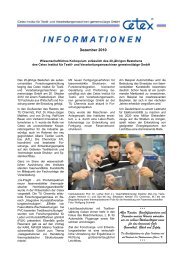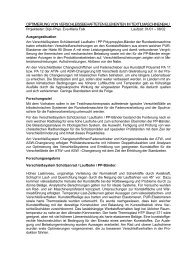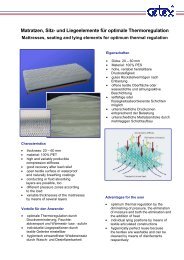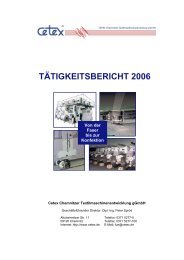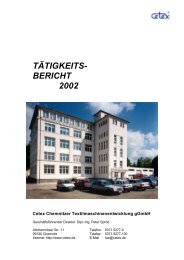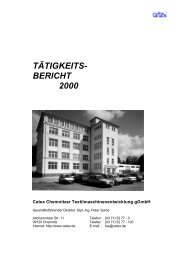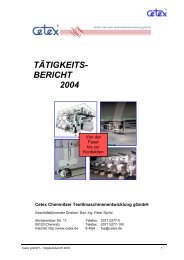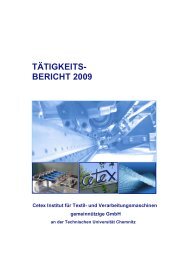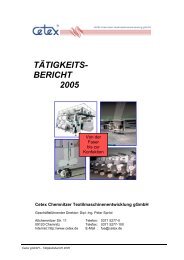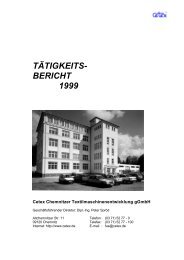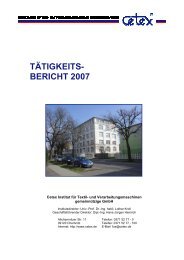Funktionelle Textilien - Cetex Institut für Textil
Funktionelle Textilien - Cetex Institut für Textil
Funktionelle Textilien - Cetex Institut für Textil
Create successful ePaper yourself
Turn your PDF publications into a flip-book with our unique Google optimized e-Paper software.
84 <strong>Textil</strong>technik<br />
Dipl.-Ing. Peter Spröd<br />
Der Autor, 1942 in Oberlichtenau geboren,<br />
arbeitete nach seinem Ingenieurstudium<br />
im Webstuhlbau Karl-Marx-<br />
Stadt (heute Schönherr Chemnitz) als<br />
Konstrukteur. Nach einem weiteren Studium<br />
an der TH Karl-Marx-Stadt war er<br />
im <strong>Institut</strong> <strong>für</strong> <strong>Textil</strong>maschinen tätig. Seit<br />
1990 ist Peter Spröd Geschäftsführender<br />
Direktor der <strong>Cetex</strong> Chemnitzer <strong>Textil</strong>maschinenentwicklung<br />
gGmbH.<br />
The author was born in Oberlichtenau<br />
in 1942 and, after graduating from engineering<br />
studies, worked as constructor<br />
in loom construction in Karl-Marx-<br />
Stadt (today Schönherr Chemnitz).<br />
After further studies at TH Karl-Marx-<br />
Stadt, he served at the <strong>Institut</strong>e of<br />
<strong>Textil</strong>e Machines. Since 1990, Peter<br />
Spröd has been Managing Director of<br />
<strong>Cetex</strong> Chemnitzer <strong>Textil</strong>maschinenentwicklung<br />
gGmbH.<br />
<strong>Funktionelle</strong> <strong><strong>Textil</strong>ien</strong> – Entwickelt in der<br />
traditionsreichen Chemnitzer Region<br />
Functional textiles – Developed in the<br />
richly traditional Chemnitz region<br />
<strong>Textil</strong>technik und <strong>Textil</strong>maschinenbau<br />
lieferten schon in der Historie Grundlagen<br />
<strong>für</strong> die technische Entwicklung<br />
und sind bis heute die Keimzelle vieler<br />
Innovationen.<br />
War es anfangs die Notwendigkeit der<br />
menschlichen Gesellschaft, sich vor<br />
Kälte und Nässe zu schützen, so sollten<br />
später bessere Qualität und große<br />
Stückzahlen produziert werden. Neue<br />
Fertigungsverfahren wurden aus der<br />
Taufe gehoben.<br />
Die Kleidung der Zukunft kann noch<br />
viel mehr: Computerchips in der Garderobe<br />
etwa sollen das Leben der Menschen<br />
leichter und sicherer machen.<br />
Schon heute ist die deutsche Bekleidungsindustrie<br />
auf dem Gebiet derartiger<br />
intelligenter <strong><strong>Textil</strong>ien</strong> führend.<br />
Nur durch ständig neue innovative Produkte<br />
ist diese Position ausbaubar.<br />
Doch die Anwendungen von <strong><strong>Textil</strong>ien</strong><br />
gehen noch viel weiter. Jetzt geht es<br />
um die Integration von klassischen textilen<br />
Materialien und deren Verarbeitung<br />
zur Findung von neuen textilen<br />
Werkstoffen <strong>für</strong> die Nutzung der vielen<br />
günstigen Eigenschaften <strong>für</strong> die späteren<br />
technischen Anwendungen. Alle <strong><strong>Textil</strong>ien</strong>,<br />
die nicht nur zur Bekleidung des<br />
Menschen dienen und einen technischen<br />
Zweck verfolgen, sind technische<br />
<strong><strong>Textil</strong>ien</strong>. Diese textilen Materialien er-<br />
bringen vielfach in technischen Anwendungen<br />
Effekte, die mit anderen Werkstoffen<br />
unerreichbar sind (wie als nachwachsende<br />
Rohstoffe oder mit dem<br />
Lotuseffekt). Mit neuen Fasern werden<br />
Festigkeiten erreicht, die mit herkömmlichen,<br />
vielfach metallischen Werkstoffen<br />
undenkbar sind, und noch dazu<br />
bei Eigengewichten, die wesentlich<br />
unter denen der Metalle liegen.<br />
Es haben sich im Laufe der Zeit viele<br />
Einsatzfelder herauskristallisiert:<br />
• Fahrzeugtechnik (etwa Automobil, Luftund<br />
Raumfahrt, Eisenbahn, Schiffe)<br />
• Verfahrenstechnik<br />
(Rohrleitung, Filter, Dichtungen)<br />
• Arbeitssicherheit (Warnkleidung,<br />
Hitzeschutz, Stichschutz)<br />
• Medizintechnik<br />
(Implantate, Wundversorgung)<br />
• Agrartechnik (Bodenbe- und<br />
-entwässerung, Pflanzbehälter)<br />
• Bautechnik (Straßen- und Wegebau,<br />
Dacheindeckung, Klimatisierung)<br />
• Transport- und Lagertechnik<br />
(Planen, Förderbänder, Big Bags)<br />
sowie <strong>für</strong> den<br />
• Sport- und Freizeitbereich<br />
(Sportgeräte und -hilfsmittel)<br />
• Industriebedarf (Walzenbeläge,<br />
Isolationen, Antriebsmittel)<br />
• Umweltschutz<br />
(Recycling, Landschaftsbau)
In early history already, textile technology<br />
and textile machine construction<br />
supplied the foundations for technical<br />
progress and until today they are the<br />
incubator of many innovations.<br />
If in the beginnings, human societies<br />
needed to protect themselves from cold<br />
and wetness, in later times, better qualities<br />
and larger item numbers were produced.<br />
New production processes were<br />
launched.<br />
Clothing of the future can even do much<br />
more: computer chips in one’s clothing<br />
for instance are to make the life of people<br />
easier and safer. Today, the German<br />
clothing industry is already leading the<br />
field of such intelligent textiles. This position<br />
can only be expanded by constantly<br />
churning out new innovative<br />
products.<br />
But the fields of application of textiles<br />
go much further than this. Now the<br />
issue is about integrating classical textile<br />
materials and their processing methods<br />
to find new textile materials to use<br />
the many favourable properties in later<br />
technical applications. All textiles that<br />
do not serve to clothe humans and are<br />
intended for technical purposes are<br />
technical textiles. These textile materials<br />
often render effects in technical applications<br />
that are unattainable with<br />
other materials (for example as renew-<br />
able primary products or with the selfcleaning<br />
Lotus effect). With the new<br />
fibres increased strengths are achieved<br />
that are unthinkable with common, often<br />
metallic materials, and that additionally<br />
have own weights that are markedly<br />
below that of metals.<br />
In the course of time, many fields of<br />
application have crystallized:<br />
• vehicle technology (automobile,<br />
aviation and space industry,<br />
railways, shipbuilding)<br />
• process technology<br />
(pipeline, filters, sealing gaskets)<br />
• occupational safety<br />
(reflective clothing,<br />
heat protection, sting protection)<br />
• medical engineering<br />
(implants, surgical dressing)<br />
• agricultural technology (soil irrigation<br />
and drainage, plant vessels)<br />
• structural engineering<br />
(road construction, roof covering,<br />
climate control)<br />
• transport and warehouse technology<br />
(canvas covers, conveyor belts,<br />
big bags)<br />
and for<br />
• the fields of sport and leisure (sport<br />
equipment and assisting devices)<br />
• industrial supplies (cylinder lining,<br />
insulating materials, fuel resources)<br />
• environmental protection<br />
(recycling, landscaping)<br />
<strong>Textil</strong>e Technology<br />
• home textiles<br />
(floor covering, light shield).<br />
Today, the share of technical textiles<br />
contained in the overall turnover generated<br />
by the German textile industry<br />
amounts to over 35 per cent. Serious<br />
forecasts estimate that the growth rate<br />
will additionally increase annually by at<br />
least 3.5 per cent until 2010.<br />
All these new fields of application require<br />
machine engineering for production<br />
as well as testing and measuring<br />
technology for determining the quality<br />
standards to be achieved. Researchers<br />
and machine engineers are confronted<br />
with high requirements in terms of the<br />
gentle treatment of completely new hightech<br />
fibres, a flexible adjustment to new<br />
products as well as user-friendly working<br />
procedures. The creation of a fibre<br />
featuring composite structures for instance<br />
and adjusting process engineering<br />
to the composite structure can only<br />
lead to success after the practical<br />
use of modern computing and drive<br />
technology systems has been implemented.<br />
These high technologies also demand a<br />
new treatment of fibres for lightweight<br />
construction. Especially the aviation industry<br />
has influenced the creation and<br />
application of new technologies to a<br />
85
86 <strong>Textil</strong>technik<br />
• Heimtextilien<br />
(Fußbodenbeläge, Lichtschutz)<br />
Der Anteil der technischen <strong><strong>Textil</strong>ien</strong> am<br />
Gesamtumsatz der deutschen <strong>Textil</strong>industrie<br />
liegt heute bei über 35 Prozent.<br />
Seriöse Prognosen rechnen bis 2010<br />
weiterhin mit jährlichen Zuwachsraten<br />
von mindestens 3,5 Prozent.<br />
Alle diese neuen Anwendungsfelder benötigen<br />
Maschinentechnik <strong>für</strong> die Fertigung<br />
sowie Prüf- und Messtechnik <strong>für</strong><br />
das Festlegen der Qualitätsparameter.<br />
Die faserschonende Verarbeitung völlig<br />
neuer Hightech-Fasern, eine flexible<br />
Produktumstellung sowie eine bedienerfreundliche<br />
Arbeitsweise stellen hohe<br />
Anforderungen an die Forscher und<br />
Maschinenbauer. Die Konzeption einer<br />
Faserverbundstruktur zum Beispiel und<br />
die Anpassung der Verfahrenstechnik<br />
an die Verbundstruktur führen erst mit<br />
der Nutzung der modernen Rechen- und<br />
Antriebstechnik zum Erfolg.<br />
Diese Hochtechnologien verlangen auch<br />
eine neue Behandlung der Fasern <strong>für</strong><br />
den Leichtbau. Besonders die Flugzeugindustrie<br />
mit der Airbus-Reihe in Europa<br />
hat die Schaffung und Anwendung<br />
neuer Technologien maßgeblich beeinflußt.<br />
Die Flugzeug-Giganten Boeing und<br />
Airbus verwenden schon lange Verbundwerkstoffe<br />
in ihren Flugzeugen.<br />
Bei den neuesten Fliegern gehen ihre<br />
Vorstellungen aber getrennte Wege.<br />
Boeing will einen komplett aus Kohlefaserkompositen<br />
bestehenden Rumpf, was<br />
einen gewaltigen Sprung in Richtung<br />
technische <strong><strong>Textil</strong>ien</strong> darstellt, während<br />
Airbus zögerlich zunächst auf Glasfaser-Aluminium-Composites<br />
setzt.<br />
Man möchte bei der Boeing 787 mindestens<br />
50 Prozent Faserverbundwerkstoffe<br />
einsetzen.<br />
Von beiden werden <strong>Textil</strong>maschinen ganz<br />
neuer Dimension <strong>für</strong> die Faserverbundkonstruktionen<br />
gebraucht.<br />
Deutschland ist bei technischen <strong><strong>Textil</strong>ien</strong><br />
zusammen mit den USA der Weltmarktführer.<br />
An dieser Position haben<br />
die <strong>Textil</strong>region Sachsen und speziell<br />
der Standort Chemnitz einen gewichtigen<br />
Anteil. Dies gründet sich auch auf<br />
Innovationen wie die MALIMO-Technologie,<br />
die heute zu den Basistechnologien<br />
bei vielen technischen <strong><strong>Textil</strong>ien</strong> gehört<br />
und bei der Sachsen weltweit mit<br />
rund 300 Patenten die eindeutige Technologieführerschaft<br />
besitzt.<br />
Unternehmen und Forschungsinstitute<br />
des <strong>Textil</strong>maschinenbaus und der <strong>Textil</strong>industrie<br />
der Region haben sich bereits<br />
zu Beginn der 90er-Jahre frühzeitig<br />
und vorausschauend auf das Knowhow-intensive<br />
Gebiet der technischen<br />
<strong><strong>Textil</strong>ien</strong> konzentriert. Heute verfügen sie<br />
in dieser dynamischen Branche nicht<br />
nur über eine starke Position, sondern<br />
gehören in einigen Spezialbereichen zu<br />
den Technologie- und Marktführern.<br />
Die Chemnitzer Firmen und Forschungseinrichtungen<br />
wie KARL MAYER Malimo<br />
<strong>Textil</strong>maschinenfabrik GmbH, Oerlikon<br />
Barmag Zweigniederlassung der Oerlikon<br />
<strong>Textil</strong>e GmbH & Co. KG, SCHÖN-<br />
HERR <strong>Textil</strong>maschinenbau GmbH, Sächsisches<br />
<strong>Textil</strong>forschungsinstitut eV,<br />
Fraunhofer-<strong>Institut</strong> <strong>für</strong> Werkzeugmaschinen<br />
und Umformtechnik, das <strong>Institut</strong><br />
<strong>für</strong> Konstruktion und Verbundbauweisen<br />
eV (KVB) und die <strong>Cetex</strong> Chemnitzer<br />
<strong>Textil</strong>maschinenentwicklung gGmbH<br />
befassen sich intensiv mit der Herstellung<br />
von Produkten und Maschinen <strong>für</strong><br />
technische <strong><strong>Textil</strong>ien</strong>.<br />
Als Produktbeispiele <strong>für</strong> die<br />
Zusammenarbeit seien genannt:<br />
• Multifunktionale<br />
bewehrte Geotextilien<br />
• Maschinen <strong>für</strong> großflächige<br />
faserverstärkte Strukturbauteile<br />
• Kunstrasen-Maschinen<br />
• <strong>Textil</strong>strukturen <strong>für</strong> die Bauarmierung<br />
• Abstandsgewebe und Abstandsgewirke<br />
<strong>für</strong> unterschiedlichste Einsatzfälle<br />
wie Klimaeinlage im Fahrzeugsitz,<br />
Matratzeneinlagen zur Klimaführung<br />
• Maschinen <strong>für</strong> Absorptionstextilien unter<br />
Verwendung von Recyclingmaterialien
1 Raschelmaschine mit Parallelschusseintrag<br />
(Detailansicht), KARL MAYER Malimo<br />
<strong>Textil</strong>maschinenfabrik GmbH<br />
Raschel machine with parallel stitching element<br />
(detailed view), KARL MAYER Malimo<br />
<strong>Textil</strong>maschinenfabrik GmbH<br />
1<br />
great extent in Europe through the Airbus<br />
series. The aircraft giants Boeing<br />
and Airbus have been using composite<br />
materials in their airplanes for a long<br />
time. With the latest planes, however,<br />
their ideas have fundamentally diverged.<br />
Boeing wants a body consisting entirely<br />
of carbon fibre composites, which<br />
means an enormous leap in the direction<br />
of technical textiles; while Airbus<br />
is hesitatingly relying on fiberglass aluminium<br />
composites for now. It is intended<br />
to use at least 50 per cent of fibre<br />
composite materials for the Boeing<br />
787.<br />
Both require textile machines of a completely<br />
new dimension for fibre composite<br />
constructions.<br />
In terms of technical textiles, Germany<br />
and the USA are world market leaders.<br />
Particularly the textile region of Saxony<br />
and especially the business location of<br />
Chemnitz play a major role in this ranking.<br />
Among other things, this is a result<br />
of the Malimo technology, which<br />
today is one of the basic technologies<br />
applied for many technical textiles and<br />
for which Saxony holds the clear technological<br />
leadership worldwide with<br />
approximately 300 patents.<br />
Already at the beginning of the nineties,<br />
companies and research institutes of textile<br />
machinery engineering and of the<br />
<strong>Textil</strong>e Technology<br />
region’s textile industry concentrated<br />
early and with foresight on the intensively<br />
know-how driven field of technical<br />
textiles. Today, they not only dispose of a<br />
strong position in this dynamic branch,<br />
but are among the technological and<br />
market leaders in certain special areas.<br />
Chemnitz-based companies and research<br />
institutions like KARL MAYER Malimo<br />
<strong>Textil</strong>maschinenfabrik GmbH, Oerlikon<br />
Barmag the branch office of Oerlikon<br />
<strong>Textil</strong>e GmbH & Co. KG, SCHÖNHERR<br />
<strong>Textil</strong>maschinenbau GmbH, Sächsisches<br />
<strong>Textil</strong>forschungsinstitut eV, the Fraunhofer<br />
<strong>Institut</strong>e for Machine Tools and<br />
Forming Technology IWU, the <strong>Institut</strong>e<br />
of Construction and Composite Material<br />
Construction – <strong>Institut</strong> <strong>für</strong> Konstruktion<br />
und Verbundbauweisen eV (KVB) and<br />
<strong>Cetex</strong> Chemnitzer <strong>Textil</strong>maschinenentwicklung<br />
gGmbH deal intensively with<br />
the manufacture of products and machines<br />
for technical textiles.<br />
The following products are mentioned as<br />
examples of the existing cooperation:<br />
• multi-functional armoured geo-textile<br />
• machines for large-scale fibrereinforced<br />
structural components<br />
• synthetic turf machines<br />
• textile structures for<br />
construction reinforcement<br />
• three-dimensional fabrics and interlaced<br />
yarns for a variety of uses like the<br />
climatisation insert in car seats, in-<br />
87
88 <strong>Textil</strong>technik<br />
2<br />
• Anlagen <strong>für</strong> multifunktionale<br />
Monofilstrukturen<br />
Zum Einsatz kommen auch folgende Rohstoffe:<br />
PA, PE, Aramide, Glas-, Carbonund<br />
Keramikfasern in Aufmachungen<br />
als Gewebe, Gewirke, Gelege (wie multiaxial,<br />
biaxial) und Geflechte.<br />
Im Folgenden werden Arbeitsschwerpunkte<br />
einiger Firmen und Forschungseinrichtungen<br />
kurz vorgestellt.<br />
Der Markt <strong>für</strong> gewirkte Multiaxialgelege<br />
ist <strong>für</strong> KARL MAYER Malimo <strong>Textil</strong>maschinenfabrik<br />
GmbH ein Wachstumsmarkt.<br />
Der Zuwachs resultiert aus dem<br />
permanenten Wachstum traditioneller<br />
Einsatzgebiete ebenso wie aus der intensiveren<br />
Erschließung neuer Einsatzmöglichkeiten<br />
wie im Automobil- oder<br />
Fahrzeugbau allgemein oder im Bereich<br />
textilbewehrter Beton.<br />
Die Verarbeitung von Spezialmaterialien<br />
wird in Zukunft noch stärker im Vordergrund<br />
stehen, dabei wird die zuneh-<br />
mende Carbonverarbeitung einen wesentlichen<br />
Schwerpunkt bilden.<br />
Das Produktprogramm von Oerlikon Barmag<br />
umfasst unter anderem Anlagen<br />
zur Herstellung von Folienbändchen<br />
und Monofilen. Der weltweite Kundenstamm<br />
stellt auf diesen Anlagen Produkte<br />
<strong>für</strong> textile Verpackungen, Teppichgrundgewebe<br />
und Kunstrasen her.<br />
Insbesondere der Markt <strong>für</strong> Kunstrasen<br />
ist nach der Freigabe von FIFA und<br />
UEFA <strong>für</strong> internationale Spiele stark<br />
wachsend. Dem Kundenstamm wird<br />
hier komplettes Engineering vom Prozess<br />
bis zur Maschine geboten. Oerlikon Barmag<br />
rüstet in diesem Marktsegment<br />
alle Weltmarktführer mit Equipment<br />
aus.<br />
Die Anlagen bestehen aus der Extrusion<br />
und Verstreckung der Monofile und Bändchen,<br />
einer Aufwicklung auf Spulen sowie<br />
der Folgeverarbeitung Zwirnen.<br />
Barmag-Spinnzwirn ist bestrebt dem<br />
Kunden „total solutions“ anzubieten. So<br />
wird auch auf dem Gebiet der textilen<br />
Verpackungen von der Extrusion bis zur<br />
Konfektion und dem Bedrucken dem<br />
Kunden ein kompletter Prozess aus einer<br />
Hand ermöglicht.<br />
Das <strong>Institut</strong> <strong>für</strong> Konstruktion und Verbundbauweisen<br />
eV (KVB) ist Komplettanbieter<br />
<strong>für</strong> Bauteile aus Faserverbundkunststoffen,<br />
beginnend von den Engineering-Dienstleistungen<br />
bis zur Kleinserienfertigung.<br />
Am <strong>Institut</strong> wurden etwa<br />
dynamisch hochbeanspruchte Bauteile<br />
<strong>für</strong> den <strong>Textil</strong>maschinenbau auf Basis<br />
CFK (Carbonfaserverstärkter Kunststoff)<br />
entwickelt. Dieser Werkstoff bietet<br />
stahlähnliche Festigkeiten und Steifigkeiten<br />
bei sehr geringer Dichte und ist<br />
<strong>für</strong> schnellbewegte Maschinen-Komponenten<br />
prädestiniert. Mit der Reduzierung<br />
der Bauteilmasse gegenüber<br />
Metallbauteilen können höhere Arbeitsfrequenzen<br />
und damit eine höhere Maschinenproduktivität<br />
erreicht werden.<br />
Die <strong>Cetex</strong> Chemnitzer <strong>Textil</strong>maschinenentwicklung<br />
gGmbH ist eine gemeinnützige<br />
Forschungseinrichtung <strong>für</strong> den
2 Monofilanlage, Oerlikon Barmag<br />
Zweigniederlassung<br />
der Oerlikon <strong>Textil</strong>e GmbH & Co. KG<br />
Monofilament plant at Oerlikon Barmag branch<br />
of Oerlikon <strong>Textil</strong>e GmbH & Co. KG<br />
3 Antriebshebel <strong>für</strong> <strong>Textil</strong>maschine,<br />
<strong>Institut</strong> <strong>für</strong> Konstruktion und<br />
Verbundbauweisen eV<br />
Driving lever for textile machine,<br />
<strong>Institut</strong>e of Construction and<br />
Composite Material Construction –<br />
<strong>Institut</strong> <strong>für</strong> Konstruktion und<br />
Verbundbauweisen eV (KVB)<br />
serts in mattresses for climate regulation<br />
• machines for absorption textiles by<br />
using recycled material<br />
• plants for multi-functional monofilament<br />
structures.<br />
Among others, the following raw<br />
materials are used: PA (polyamides),<br />
PE (polyethylenes), aramides, glass,<br />
carbon and ceramic fibres in makingups<br />
as fabrics, yarns, stapled fabrics<br />
(multi-axial, bi-axial etc.) and meshwork.<br />
In the following, we present several focal<br />
points various firms and research<br />
institutes are currently working on.<br />
The market for stapled yarns produced<br />
as multi-axial stapled fabrics represents<br />
a growth market for Messrs.<br />
KARL MAYER Malimo <strong>Textil</strong>maschinenfabrik<br />
GmbH. This increase is a result<br />
of the permanently growing traditional<br />
areas of application as well as of the<br />
more intensively developed new possibilities<br />
for application, for instance in<br />
automobile and vehicle construction<br />
generally or in the field of textile-reinforced<br />
concrete.<br />
The processing of specialized material<br />
will acquire even greater significance in<br />
future, whereby the increased processing<br />
of carbon will play an essential<br />
role.<br />
The product programme of Oerlikon<br />
Barmag comprises, among other things,<br />
plants for the production of small film<br />
strips and monofilaments. Customers<br />
worldwide manufacture products for textile<br />
packaging, basic carpet fabrics and<br />
synthetic turf with these plants. Since<br />
the FIFA and UEFA have released it for<br />
international games, the market for<br />
synthetic turf in particular has been<br />
growing strongly. Clients receive here<br />
comprehensive engineering services,<br />
ranging from processing through to the<br />
final machine itself. Oerlikon Barmag<br />
supplies all global market leaders in this<br />
segment with the relevant equipment.<br />
Plants contain extrusion and stretching<br />
facilities for monofilaments and film<br />
strips, coiling devices for spools and continuing<br />
processing devices for threads.<br />
Barmag-Spinnzwirn endeavours to offer<br />
its clients “total solutions”. Indeed,<br />
in the field of textile packaging clients<br />
can receive one-stop comprehensive services<br />
ranging from extrusion to confection<br />
and printing.<br />
The <strong>Institut</strong>e of Construction and Composite<br />
Material Construction – <strong>Institut</strong><br />
3<br />
<strong>Textil</strong>e Technology<br />
<strong>für</strong> Konstruktion und Verbundbauweisen<br />
eV (KVB) – provides comprehensive services<br />
for components made of fibre composite<br />
plastics, starting with engineering<br />
services through to the production<br />
of small series. The institute developed<br />
for instance dynamically highly-stressed<br />
components for textile machine construction<br />
on the basis of CFP (carbonfibre-reinforced<br />
plastics). This material<br />
offers a solidity and stiffness near to<br />
steel at very low density and is predestined<br />
for fast-moving machine components.<br />
By reducing the component mass<br />
against metal components, it is possible<br />
to achieve higher working frequencies<br />
and thus a higher machine productivity.<br />
<strong>Cetex</strong> Chemnitzer <strong>Textil</strong>maschinenentwicklung<br />
gGmbH is a charitable research<br />
institution for textile machine construction<br />
and adjoining fields. Machines<br />
for the processing of technical textiles<br />
are an important focal point of research.<br />
This includes the development of<br />
machine technology for the processing<br />
of high-performance fibres (carbon/<br />
glass/aramide) bi- and triaxial structures<br />
or multi-axial stapled structures as<br />
well as for the production of geo-textiles.<br />
Other projects deal with new methods<br />
of forming stapled fabrics, knitters<br />
for 3D-textiles and special sewing<br />
machines for composites.<br />
89
90 <strong>Textil</strong>technik<br />
<strong>Textil</strong>maschinenbau und angrenzende<br />
Bereiche. Maschinen <strong>für</strong> die Verarbeitung<br />
technischer <strong><strong>Textil</strong>ien</strong> bilden einen<br />
wichtigen Forschungsschwerpunkt. Dazu<br />
gehören die Entwicklung von Maschinentechnik<br />
<strong>für</strong> die Verarbeitung<br />
von Hochleistungsfasern (Carbon/Glas/<br />
Aramid), bi- und triaxialen Strukturen<br />
oder multiaxialen Gelegestrukturen sowie<br />
<strong>für</strong> die Herstellung von Geotextilien.<br />
Weitere Projekte beschäftigen sich<br />
mit neuen Gelegebildungsverfahren,<br />
Wirkmaschinen <strong>für</strong> 3D-<strong><strong>Textil</strong>ien</strong> sowie<br />
Spezialnähmaschinen <strong>für</strong> Composites.<br />
Die Einrichtung kann dabei auf langjährige<br />
Erfahrungen aus nahezu allen<br />
Bereichen des <strong>Textil</strong>maschinenbaus zurückgreifen,<br />
die Vorgängereinrichtung<br />
<strong>Institut</strong> <strong>für</strong> <strong>Textil</strong>maschinen wurde bereits<br />
1957 gegründet. 2007 heißt es also:<br />
50 Jahre <strong>Cetex</strong> und Vorgängereinrichtung.<br />
Der Förderverein <strong>Cetex</strong> Chemnitzer <strong>Textil</strong>maschinenentwicklung<br />
eV als Gesellschafter<br />
der Forschungseinrichtung<br />
bildet das Bindeglied zwischen <strong>Textil</strong>maschinenbau<br />
und <strong>Textil</strong>industrie. Er<br />
fördert die Kontakte zwischen Forschungseinrichtungen<br />
und der Industrie.<br />
Gemeinsam mit der Technischen Universität<br />
Chemnitz und dem Verband der<br />
Nord-Ostdeutschen <strong>Textil</strong>- und Bekleidungsindustrie<br />
führt der Förderverein<br />
alle zwei Jahre die Chemnitzer <strong>Textil</strong>maschinen-Tagung<br />
durch, die sich bei<br />
Fachleuten der Branche im In- und Ausland<br />
einer immer größeren Resonanz<br />
erfreut. 2007 wird diese Veranstaltung<br />
zu einer <strong>Textil</strong>technik-Tagung erweitert.<br />
Das Vorstandsmitglied des <strong>Cetex</strong> eV –<br />
Herr Profesor Rudolph – ist gleichzeitig<br />
<strong>Textil</strong>beauftragter des Sächsischen<br />
Staatsministeriums <strong>für</strong> Wirtschaft und<br />
Arbeit (SMWA) und Geschäftsführer des<br />
INNtex eV. Dieser unterstützt mit weiteren<br />
Initiativen, Netzwerken und Aktivitäten<br />
die Wirtschaft tatkräftig.<br />
Ferner hat das SMWA den INNtex eV mit<br />
der Leitung der neuen Verbundinitiative<br />
Technische <strong><strong>Textil</strong>ien</strong> beauftragt. Haupt-<br />
ziel der Verbundinitiative ist es, die Umprofilierung<br />
der traditionsreichen sächsischen<br />
<strong>Textil</strong>industrie in neue, innovative<br />
Wachstumsfelder nachhaltig zu<br />
unterstützen.<br />
Ein weiterer Meilenstein <strong>für</strong> die Region<br />
war die „mtex“, eine internationale Fachmesse<br />
<strong>für</strong> technische <strong><strong>Textil</strong>ien</strong> im Fahrzeugbau,<br />
die 2006 erfolgreich startete<br />
und deren nächste Auflage <strong>für</strong> den<br />
03.–05. Juni 2008 geplant ist.<br />
Chemnitz als traditionelle <strong>Textil</strong>- und<br />
Automobilstadt mit ihrer Forschungsund<br />
Industriedichte bietet eine ideale<br />
Kontaktplattform <strong>für</strong> einen länderübergreifenden<br />
Erfahrungsaustausch.<br />
4
5<br />
6<br />
The institute draws from a long-standing<br />
experience in almost all field of textile<br />
machine construction, the predecessor<br />
institute for textile machines was established<br />
as early as 1957. Therefore in<br />
2007, 50 years of <strong>Cetex</strong> and its predecessor<br />
are celebrated.<br />
The association of sponsors Förderverein<br />
<strong>Cetex</strong> Chemnitzer <strong>Textil</strong>maschinenentwicklung<br />
eV forms a link between<br />
the sector of textile machine construction<br />
and the textile industry as shareholder<br />
in the research institute.<br />
In collaboration with Chemnitz Technical<br />
University and the Association of<br />
North-Eastern German <strong>Textil</strong>e and Clothing<br />
Industry, the association of spon-<br />
sors organises the Chemnitz <strong>Textil</strong>e<br />
Machines Conference every two years,<br />
which enjoys an increasing resonance<br />
among experts in the branch domestically<br />
and abroad. In 2007 this event<br />
will be extended to include a textiles<br />
conference.<br />
Member of the executive board of <strong>Cetex</strong><br />
eV – Prof. Rudolph – is also the<br />
appointed commissioner for textiles of<br />
the Saxon State Ministry for Trade, Commerce<br />
and Labour (SMWA), as well as<br />
Managing Director of INNtex eV The<br />
latter supports the industry actively<br />
with additional initiatives, networks and<br />
activities. Furthermore, SMWA appointed<br />
INNtex eV to manage the new Cooperation<br />
Initiative Technical <strong>Textil</strong>es.<br />
<strong>Textil</strong>e Technology<br />
4 + 6 Doppelraschelwirkmaschine<br />
zur Herstellung hoher, druckelastischer<br />
Abstandsgewirke und darauf produzierte<br />
<strong><strong>Textil</strong>ien</strong> (<strong>Cetex</strong> Chemnitzer <strong>Textil</strong>maschinenentwicklung<br />
gGmbH, Lizenznehmer und<br />
Maschinenproduzent: KARL MAYER<br />
<strong>Textil</strong>maschinenfabrik GmbH, Obertshausen)<br />
Double-needle bar Raschel machine for<br />
the production of high, pressure-elastic spacer<br />
fabrics and textile produced upon it (<strong>Cetex</strong><br />
Chemnitzer <strong>Textil</strong>maschinenentwicklung gGmbH,<br />
licencee and machine producer: KARL MAYER<br />
<strong>Textil</strong>maschinenfabrik GmbH, Obertshausen)<br />
5 Faserverbundbauteil aus<br />
Multiaxialgelegen (<strong>Cetex</strong> Chemnitzer<br />
<strong>Textil</strong>maschinenentwicklung gGmbH)<br />
Fibre composite component from<br />
multiaxial warp fabrics (<strong>Cetex</strong> Chemnitzer<br />
<strong>Textil</strong>maschinenentwicklung gGmbH)<br />
The main aim of the Cooperation Initiative<br />
is to support the transformation<br />
of the profile of the traditional Saxon<br />
textile industry into new, innovative<br />
growth fields sustainably.<br />
A further milestone for the region was<br />
“mtex”, an international trade fair for<br />
industrial textiles in motor vehicle<br />
manufacturing, which started successfully<br />
in 2006 and which is next planned<br />
to take place from 3 to 5 June 2008.<br />
As a traditional textile and automotive<br />
city, Chemnitz offers an ideal platform<br />
for fostering contacts aimed at a crossregional<br />
exchange of experiences because<br />
of its extreme density of existing<br />
research institutes and its industrial<br />
activities.<br />
91



